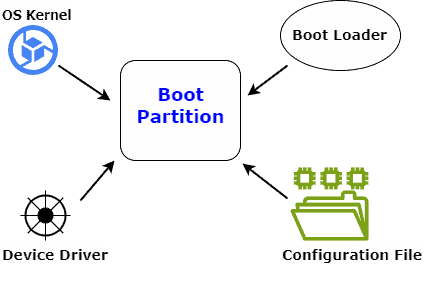1. Introduction
In this tutorial, we’ll talk about boot partition and the recommended ideal partition size in case of different operating systems.
2. What Is Boot Partition?
A boot partition, also called a boot volume or drive, is a section of a storage device like a hard drive, SSD, or partition within a larger disk holding important files for starting a computer.
It contains crucial system files such as the OS kernel, bootloader, drivers, and settings needed to initialize the OS and other software during startup.
3. Component of Boot Partition
The components of a boot partition generally include:
3.1. Bootloader
When a computer starts, it executes a small program or piece of code called a bootloader. Its primary function is to load and start the operating system or other firmware necessary for the computer to operate. The computer’s hardware executes bootloaders during the boot process, typically storing them in non-volatile memory such as Read-Only Memory or flash memory. Examples include GRUB and Windows Boot Manager.
3.2. Operating System Kernel
The kernel is the operating system boss, managing memory, programs, and hardware. The bootloader brings it into memory, and it ensures smooth software operation:

3.3. Device Drivers
Device drivers are computer translators. They help the operating system talk to hardware like drives and graphics cards. The boot partition stores essential drivers for a smooth computer start-up.
3.4. Configuration Files
Configuration files are computer manuals. They store settings for computers and apps, like start-up and program preferences. Storing them in the boot partition ensures they’re ready for a smooth computer start-up.
4. Importance of Boot Partition
A separate boot partition protects crucial files from harm and helps in recovery from OS issues. Even though it can enable multi-booting, users can install and choose between different operating systems at the startup.
It also enhances system security by loading only authorized software components, preventing malicious software compromise. However, a well-designed boot partition can improve system performance by optimizing the boot process and reducing boot times.
Even if the primary OS partition gets corrupted, a healthy boot partition can still help access recovery tools and potentially fix the issue without losing data.
In Windows, it often refers to the system partition. This partition holds both the bootloader and the main operating system files. However, in other operating systems like Linux, the boot partition and system partition are usually separate. The boot partition contains the bootloader, while the system partition stores the main operating system files.
5. Factors Influencing Boot Partition Size
The sizes of bootloader and kernel files affect the boot partition size. Bootloaders like GRUB or Windows Boot Manager need space for config files and code. Kernel size, with extra modules or drivers, also influences the partition’s space needed.
In the case of multi-boot setups with multiple OSs on one computer, each OS may need its boot partition. The size of these partitions depends on each OS’s needs and the bootloaders. Also, space is needed to manage boot entries and configs for each OS.
The file system type, such as FAT32, NTFS, and ext4, affects the boot partition size. Each file system has different overheads like metadata, journaling, and system reserved space. Choosing a file system and formatting options impacts the available space on the boot partition.
While deciding the boot partition size, planning for future growth is vital. Updates, kernel upgrades, and new software may need more space. Allocating extra space initially can handle future changes without resizing or reconfiguring the partition.
The boot partition size may also be influenced by the system architecture, like 32-bit vs. 64-bit, and the firmware interface used for booting BIOS or UEFI. UEFI systems typically require a larger boot partition than BIOS systems due to additional firmware files and support for larger disk capacities.
6. Recommended Boot Size Range
Based on the factors explained earlier, the recommended boot partition size range for different scenarios can be summarized as follows:
A boot partition size ranging from 100 to 500 MB is sufficient for most Linux distributions. However, if we plan to install multiple kernels or have specific requirements, it may need a larger boot partition.
The System Reserved partition size for Windows operating systems is typically around 100 MB. We use this partition to store boot-related files and the boot configuration data (BCD). Ensure that the System Reserved partition meets the minimum size requirement specified by Microsoft for the installed Windows version.
When establishing a multi-boot setup featuring multiple operating systems, it’s advisable to designate an individual boot partition for each operating system. We should determine the sizing of these boot partitions by considering the factors outlined earlier while also accounting for the specific requirements of each operating system.
Overall, we can say that the optimal size depends on individual needs and usage patterns. Even regular reviews to adjust the size as per the requirements of the current situation are essential.
7. Conclusion
In this article, we discussed boot partition along with its various components and the recommended size of boot partition in case of different operating systems. The suggested boot partition size depends on factors like the OS, system type, computer use, and recommendations from vendors or administrators.